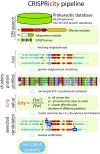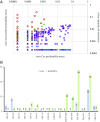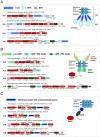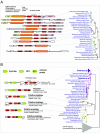Systematic prediction of genes functionally linked to CRISPR-Cas systems by gene neighborhood analysis
- PMID: 29784811
- PMCID: PMC6003329
- DOI: 10.1073/pnas.1803440115
Systematic prediction of genes functionally linked to CRISPR-Cas systems by gene neighborhood analysis
Abstract
The CRISPR-Cas systems of bacterial and archaeal adaptive immunity consist of direct repeat arrays separated by unique spacers and multiple CRISPR-associated (cas) genes encoding proteins that mediate all stages of the CRISPR response. In addition to the relatively small set of core cas genes that are typically present in all CRISPR-Cas systems of a given (sub)type and are essential for the defense function, numerous genes occur in CRISPR-cas loci only sporadically. Some of these have been shown to perform various ancillary roles in CRISPR response, but the functional relevance of most remains unknown. We developed a computational strategy for systematically detecting genes that are likely to be functionally linked to CRISPR-Cas. The approach is based on a "CRISPRicity" metric that measures the strength of CRISPR association for all protein-coding genes from sequenced bacterial and archaeal genomes. Uncharacterized genes with CRISPRicity values comparable to those of cas genes are considered candidate CRISPR-linked genes. We describe additional criteria to predict functionally relevance for genes in the candidate set and identify 79 genes as strong candidates for functional association with CRISPR-Cas systems. A substantial majority of these CRISPR-linked genes reside in type III CRISPR-cas loci, which implies exceptional functional versatility of type III systems. Numerous candidate CRISPR-linked genes encode integral membrane proteins suggestive of tight membrane association of CRISPR-Cas systems, whereas many others encode proteins implicated in various signal transduction pathways. These predictions provide ample material for improving annotation of CRISPR-cas loci and experimental characterization of previously unsuspected aspects of CRISPR-Cas system functionality.
Keywords: CRISPR-Cas; computational genomics; gene neighborhoods; membrane proteins; signaling.
Conflict of interest statement
The authors declare no conflict of interest.
Figures





Similar articles
-
CRISPRCasdb a successor of CRISPRdb containing CRISPR arrays and cas genes from complete genome sequences, and tools to download and query lists of repeats and spacers.Nucleic Acids Res. 2020 Jan 8;48(D1):D535-D544. doi: 10.1093/nar/gkz915. Nucleic Acids Res. 2020. PMID: 31624845 Free PMC article.
-
CRISPR Arrays Away from cas Genes.CRISPR J. 2020 Dec;3(6):535-549. doi: 10.1089/crispr.2020.0062. CRISPR J. 2020. PMID: 33346707 Free PMC article.
-
The CRISPR Spacer Space Is Dominated by Sequences from Species-Specific Mobilomes.mBio. 2017 Sep 19;8(5):e01397-17. doi: 10.1128/mBio.01397-17. mBio. 2017. PMID: 28928211 Free PMC article.
-
[Why so rare if so essentiel: the determinants of the sparse distribution of CRISPR-Cas systems in bacterial genomes].Biol Aujourdhui. 2017;211(4):255-264. doi: 10.1051/jbio/2018005. Epub 2018 Jun 29. Biol Aujourdhui. 2017. PMID: 29956652 Review. French.
-
CRISPR-Cas: evolution of an RNA-based adaptive immunity system in prokaryotes.RNA Biol. 2013 May;10(5):679-86. doi: 10.4161/rna.24022. Epub 2013 Feb 25. RNA Biol. 2013. PMID: 23439366 Free PMC article. Review.
Cited by
-
Positioning Diverse Type IV Structures and Functions Within Class 1 CRISPR-Cas Systems.Front Microbiol. 2021 May 21;12:671522. doi: 10.3389/fmicb.2021.671522. eCollection 2021. Front Microbiol. 2021. PMID: 34093491 Free PMC article.
-
Prokaryotic innate immunity through pattern recognition of conserved viral proteins.Science. 2022 Aug 12;377(6607):eabm4096. doi: 10.1126/science.abm4096. Epub 2022 Aug 12. Science. 2022. PMID: 35951700 Free PMC article.
-
Systematic prediction of genes functionally associated with bacterial retrons and classification of the encoded tripartite systems.Nucleic Acids Res. 2020 Dec 16;48(22):12632-12647. doi: 10.1093/nar/gkaa1149. Nucleic Acids Res. 2020. PMID: 33275130 Free PMC article.
-
Revealing bacteria-phage interactions in human microbiome through the CRISPR-Cas immune systems.Front Cell Infect Microbiol. 2022 Sep 28;12:933516. doi: 10.3389/fcimb.2022.933516. eCollection 2022. Front Cell Infect Microbiol. 2022. PMID: 36250060 Free PMC article.
-
Three New Cs for CRISPR: Collateral, Communicate, Cooperate.Trends Genet. 2019 Jun;35(6):446-456. doi: 10.1016/j.tig.2019.03.009. Epub 2019 Apr 27. Trends Genet. 2019. PMID: 31036344 Free PMC article. Review.
References
-
- Sorek R, Lawrence CM, Wiedenheft B. CRISPR-mediated adaptive immune systems in bacteria and archaea. Annu Rev Biochem. 2013;82:237–266. - PubMed
-
- Wright AV, Nuñez JK, Doudna JA. Biology and applications of CRISPR systems: Harnessing nature’s toolbox for genome engineering. Cell. 2016;164:29–44. - PubMed
-
- Mohanraju P, et al. Diverse evolutionary roots and mechanistic variations of the CRISPR-Cas systems. Science. 2016;353:aad5147. - PubMed
-
- Barrangou R, Horvath P. A decade of discovery: CRISPR functions and applications. Nat Microbiol. 2017;2:17092. - PubMed
Publication types
MeSH terms
Substances
LinkOut - more resources
Full Text Sources
Other Literature Sources

